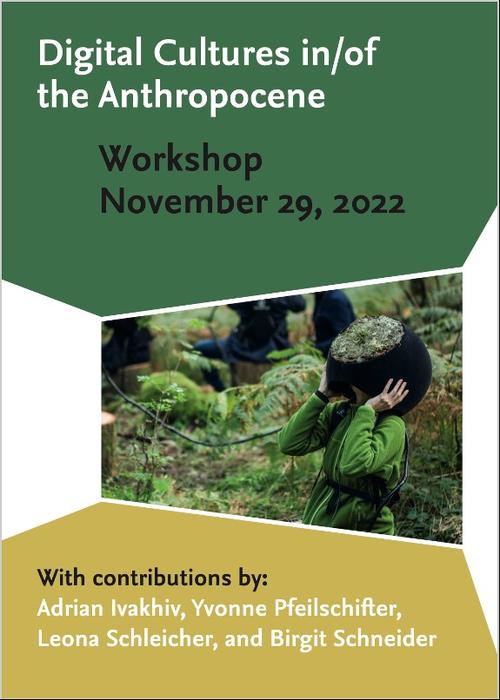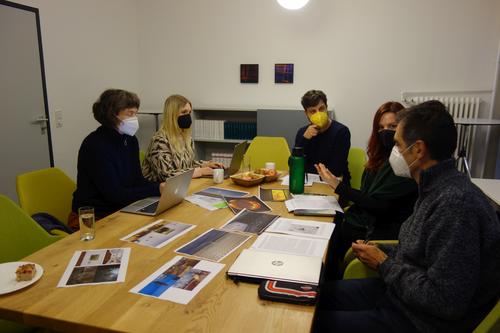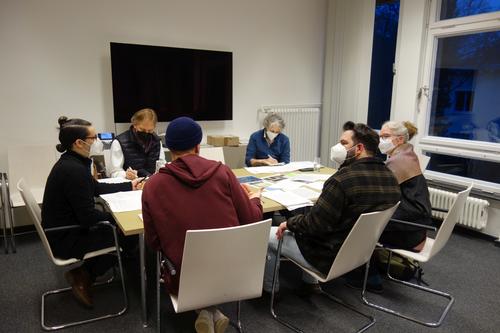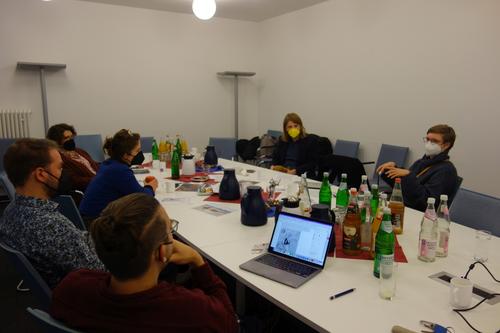Digital Cultures in/of the Anthropocene
29.11.2022 | Workshop by the Cinepoetics group with Adrian Ivakhiv, Yvonne Pfeilschifter, Leona Schleicher, and Birgit Schneider.
Research Focus: Audiovisual Cultures II: Phenomenology of the Anthropocene
On the morning of October 29th, the Cinepoetics group gathered for the first workshop of the semester with the fellows Jennifer Barker, Enis Dinç, Adrian Ivakhiv, Angelos Koutsourakis, Inga Pollmann, Birgit Schneider, and Robert Sinnerbrink present. As the numerous participants were caught up in a quiet murmur, Matthias Grotkopp opened the event by introducing this semester's research focus on the phenomenology of the Anthropocene and its impact on the studies of digital methods of moving images. Opening up possibilities of reflection upon digital environments and their implications of visibility, the image, and the imagined, the workshop started with a presentation by Adrian Ivakhiv (University of Vermont).
Ivakhiv introduced his talk, "Ecologies of the Digital in the Anthro-Capitalo-Datacene," by announcing his research to be part of a book he is currently working on. The first part comprised of the question of what kinds of digital images exist and how the relationship to their counterparts, the non-digital images, is constituted. He highlighted the importance of contextualising the digital image: its production, storage, and archive as well as its socio-political impact – and therefore its re-territorialisation. The term "slippery morphing image" may encapsulate Ivakhiv's different modes of categorising ecologies and film worlds, while offering a definition of the mouldable, modulable, and remediable digital image. He closed his talk by reflecting on the relationship between the digital image and surveillance capitalism as well as their impact in the current petro-morphogenocene.
After a short break, the presentation of Leona Schleicher and Yvonne Pfeilschifter (both: Freie Universität Berlin) "Disrupting the Horizontal: Digital Landscapes in Movement" shifted the perspective to the verticality of images. Schleicher introduced their current research on mobile phone videos depicting landscapes severely affected by climate change on social media platforms. On the one hand these vertical images stress the spontaneity of the filmed landscape, on the other hand they heighten the importance of what lies outside the frame. Pfeilschifter continued this line of thought with an extract from the Netflix series OUR NATURE (2019) that made use of the Cineflex technology. As seen in the clip, the vertical movement of walruses falling into the depth of a cliff disrupts the horizontal orientation of the images and thus opens up a reflection on climate change that roots patterns of the sensory experience of moving images.
The following discussion revolved around the critique of the colonial gaze towards nature, and the separation between spaces populated by humans and nature. Referring to different filmic examples like NANOOK OF THE NORTH and MIDSOMMAR, the discussion opened up more space for reflection and with these ideas in mind, the workshop had an intermission with a lunch break.
Birgit Schneider's talk "Operating the Green Marble: Setting Global Forest Maps in Motion" transposed the discussions from earlier in the day into a different domain. In analysing the sensory aesthetics as well as the immediate social impact of the web-based mapping tool "Global Forest Watch," Schneider presented her insights on mapping and scaling as processes of sense-making within the context of the Anthropocene. As this interactive tool conflates the scopic regime of the bird's eye view with individual and localized climate knowledge, Schneider pointed towards a new way of thinking about operational images. She understood this contradiction of a global view and a lived world as an important connection point for her further research that also takes embodied knowledge of maps (and mapping) into account.
After a short break, the group was divided into three discussion groups. Each group had a tableful of images as well as short text extracts to discuss and work with. After this breakout session, the whole group gathered to present their results and topics of discussion to each other. Leona Schleicher and Hannes Wesselkämper addressed digital screens and the fragmentation of attention spans that go hand in hand with the disembodied experience of doomscrolling. Thomas Scherer referred to wordplays and associations that go with the word landscape, e.g. scapegoat and escape, and underlined landscape as a spatial and mental surrounding. Matthias Grotkopp closed the workshop with his input on networked sensors and nervous systems which can be understood as an evolving system and as relationships of re-working and re-arranging.





